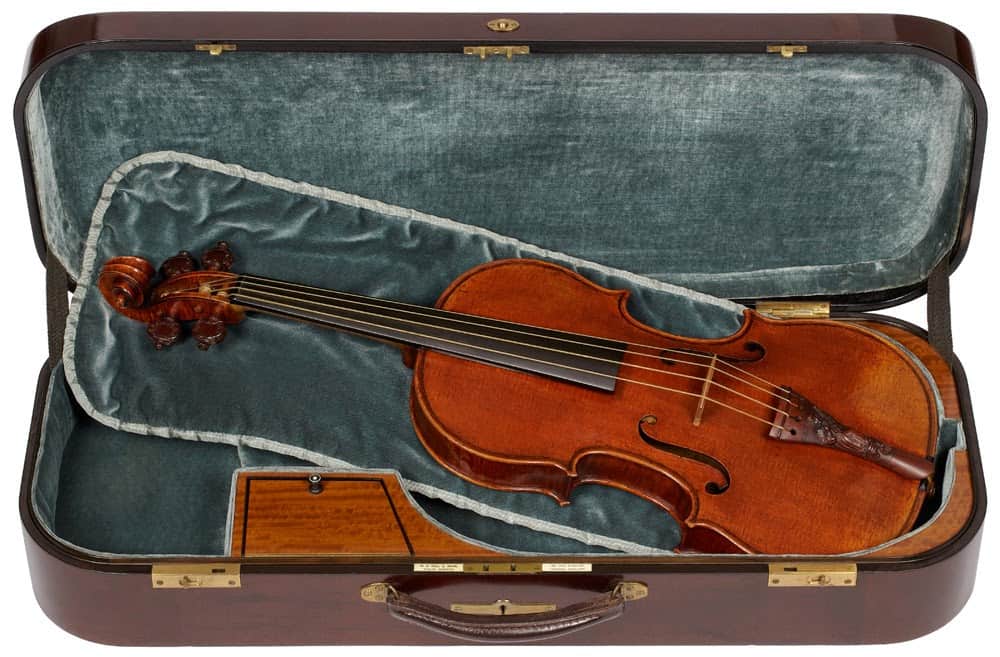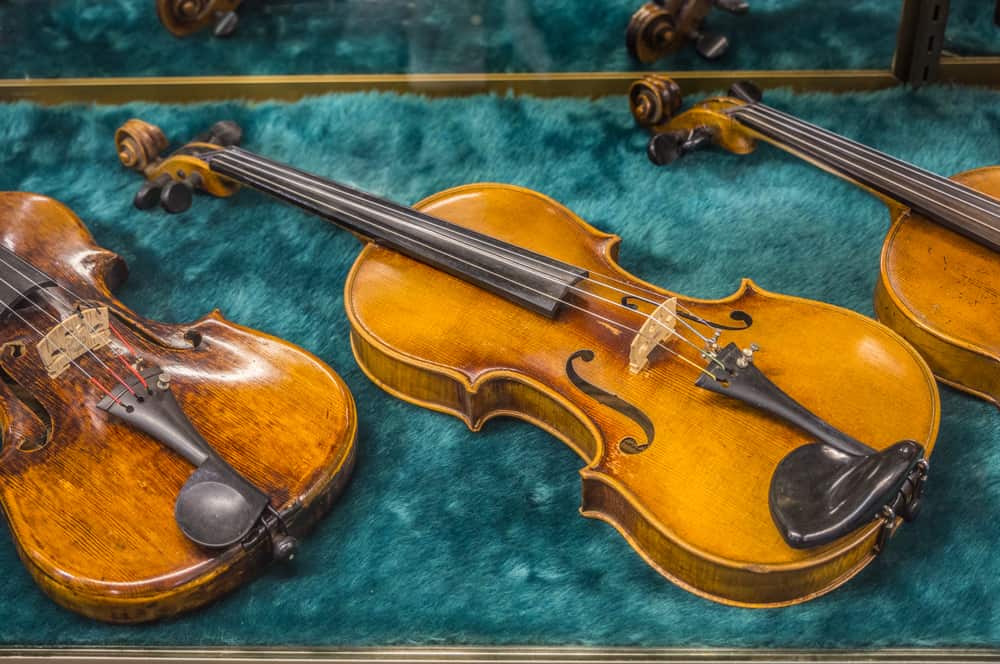Do you have an antique violin lying around in your attic? If so, you may be wondering what its worth.
Antique violins are some of the most valuable instruments in the world. The specific value of antique violins, though, can vary greatly depending on many factors.
In this blog post, we will take a look at some of the most valuable violins ever made, as well as discuss some of the factors that affect price. We will also look at some famous violin makers and their instruments to hopefully give you a better idea of what your antique violin might be worth.
Let’s get started!
Table of Contents
A Brief History of Violins
The history of the modern violin dates back to the 16th century, when it was first invented in Italy. It is most often credited to a man named Andrea Amati, although some claim it was first invented by a man named Gasparo de Salò.
Amazingly, the oldest violin known to still exist was built by Andrea Amati in 1564 and is nicknamed the Charles IX, after the King of France at the time.
However, the violin as we know it today was not perfected until the 18th century, when Antonio Stradivari and other famous violin makers began to craft some of the most legendary instruments in history.
Today, violins are a well-known and well-loved instrument used in both orchestras and solo performances around the world.
Famous Makers Of Antique Violins
Now that we know the history of the violin, let’s look at two of the most famous makers of antique violins. Many violins by these makers are still in existence (and even played!) today.
Antonio Stradivari

Antonio Stradivari is arguably the most famous violin maker of all time. He was born in 1644 in Cremona, Italy and began making violins around 1666.
It is believed that he made thousands of instruments in his lifetime with around 650 of his violins still existing today. His instruments are highly sought after by collectors and musicians alike and are some of the most valuable and best violins in the world.
Some of his most famous violins include the “Lady Blunt” (named after Lady Anne Blunt, who owned it for about 30 years), the “ex-Ries” (formerly owned by the French composer Hector Berlioz), and the “Molitor” (named after Count Gabriel Jean Joseph Molitor, who was a general in the Bonaparte Army).
To give you an idea of the value of his violins, his “Lady Blunt” violin was sold at a charity auction for 11.6 million euros! The 1693 “ex-Ries” violin is valued at 3.5 million and is still being played today by Hungarian musician József Lendvay. And the “Molitor” was purchased at a 2010 auction by American violinist Anne Akiko Meyers for an amazing 2.7 million euros.
Guarneri del Gesù

Bartolomeo Giuseppe “del Gesù” Guarneri was another famous Italian violin maker from the 18th century. He was born in 1698 and apprenticed under Nicolò Amati (the grandson of Andrea Amati).
He is most known for his unique violins, which were said to have a “darker” sound than those made by Stradivari, making them a favorite instrument by some soloists. His violins are very collectable by experts on the subject. He not only made violins, but he also made cellos and violas.
Some of his most famous violins include the “Vieuxtemps Guarneri” (named after Belgian composer Henri Vieuxtemps, who owned it for many years), the “Carrodus Guarneri” (built a year before Guarneri died and named after owner John Carrodus), and the “Ex-Kochanski Guarneri” (named after Polish violinist Paul Kochanski, who owned it for quite a long time).
If you are wondering at the valuation of his violins, here are some of his most valuable. The “Vieuxtemps Guarneri” violin was purchased by an undisclosed buyer for around $16 million and is on lifetime loan to American violinist Anne Akiko Meyers. The “Carrodus Guarneri” violin has a whopping evaluation of at least $10 million. And the “Ex-Kochanski Guarneri” sold for $10 million at an auction in 2009!
How To Tell If My Antique Violin Is Valuable
Now that we’ve looked at some of the most famous luthiers and their valuable violins in history, let’s discuss how to tell if a violin is of high quality and value. You’ll want to test a violin against a few key factors: age, material, the maker, sound, and condition.
There are a few factors that affect the value of a violin:
The Age of the Violin
Age is one factor that affects the value of an antique violin. Generally speaking, older violins are more valuable than newer ones. This is especially true if they were made by master craftsmen during what is known as the “golden period” of violin making (roughly from 1700-1750). Instruments made during this time are highly sought after by collectors and musicians alike.
The Materials Used in the Violin
The materials used to make a violin also affect its value. Higher quality violins are typically made with better woods, such as spruce for the top and maple for the back and sides. They will also have higher quality fittings, such as an ebony fingerboard.
The Maker of the Violin
The maker of the instrument is also important. As we’ve discussed, some makers in history have a sturdy reputation when it comes to building violins. A violin made by a well-known luthier will be worth more than one made by an unknown maker, and you can trust the quality to be higher too.
The Sound Of The Violin
Of course, the sound of the violin is extremely important in determining its quality. A higher quality violin will have a richer, fuller sound, while a lower quality one will have a thinner, less resonant sound.
Condition of the Violin
If a violin has been well-maintained throughout its life, it will be worth more than one that has not. This is because any repairs that have been made will be of high quality and will not affect the sound or playability of the instrument.
Once you have used these factors to weigh the violin in question, the next thing to do is to take it to a qualified appraiser. Explain all that you know about the instrument. If you happen to know the history of your violin (called the “provenance”), then disclose that as well.
A qualified appraiser will be able to tell you more about the history of your instrument and give you an official appraisal.
A Guide to Buying Vintage Violins
Now that we’ve looked at the value of antique violins, let’s discuss how to buy one.
There are a few things you need to keep in mind when buying a vintage violin:
The Condition of The Violin
As we mentioned before, the condition of the violin is very important. You want to make sure that there are no cracks or repairs, and that all the seams are tight. It’s also important to check for any wear on the fingerboard or other parts of the instrument.
The Sound Of The Violin
Of course, you’ll also want to make sure that the sound of the violin is good. Take it to a qualified violinist and have them play it for you. Listen for any cracks or other imperfections in the sound.
The Price
When you’re buying a vintage violin, you need to be aware of the current market conditions. Check online and see what similar violins are selling for. You don’t want to overpay for your instrument, but you also don’t want to underestimate it.
Get an Official Appraisal
Once you’ve found a violin that you’re interested in, it’s always a good idea to get an official appraisal. This will help you determine the value of the violin and make sure that you’re paying a fair price.
An antique violin can be a great addition to any musician’s collection. With a little bit of research, you can find a beautiful instrument that will last for many years to come.
Just remember to keep the above factors in mind when you’re making your purchase. And if you have any doubts, always get an official appraisal. With a little bit of knowledge, you can be sure to find a violin that is perfect for you.
In Conclusion
We hope you enjoyed this article on the value of antique violins. Remember to keep the above factors in mind when making your purchase, and always get an official appraisal before finalizing the sale. If you enjoyed this article, please share it with your friends or family who might be interested in learning more about antique violins.
Do you have an old violin that you think might be valuable? Share your story with us in the comments below!

I have an older violin I think it could be worth something
I have my grandfathers violin but it has been out of its case for a couple of decades as my mother had it displayed under glass with a photo of him posing with it when he was just 17. He was born in 1907 and according to my mom he bought the violin used. The front has a split and the varnish is crackled. The fingerboard has come unglued. It has a label inside that states it’s a Stradivarius copy. I have two granddaughters that have just started violin lessons. Just wondering if it’s worth having it repaired or if it sounds like it’s too far gone.
Point of information: Regarding Joseph Guarneri del Gesu, he did not make any violas and there is one cello attributed to him, although this may be debatable. No one knows how many violins he made in his lifetime, probably around 300 which is an approximate figure. His work is not consistent throughout his life, but he did make masterpieces that compare to his older rival, Antonio Stradivari. His violins gained their reputation when Paganini played one and it became his primary instrument. My personal thought, what might been the result if Paganini did not play a Guarneri? It took about 100 years for Guarneri to gain his reputation. Stradivari was famous during his lifetime as an outstanding luthier.
I have a Jacobus Stemer Violin made in 1725.
The original case and manufacturer’s label are visible inside the Violin.
Do you know if it has any value based on its age and rarity or do I just own an old Violin?